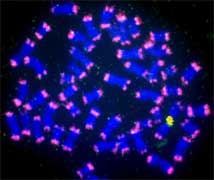Repetitive sequences originating from the centromere constitute large-scale heterochromatin in the telomere region in the siamang, a small ape古賀章彦・平井百合子・原暢・平井啓久 【背景】チンパンジーの染色体の端部には、大規模なヘテロクロマチンがある。これに相当する構造物は、ヒトの染色体にはみられない。共通祖先から分岐した後ヒトのほうの系列でこれが消失したことを、2011年の論文で示した。この消失はヒトの進化の原因または結果であると推測される。同様の現象がテナガザル科でみられる。フクロテナガザル(Symphalangus syndactylus)には染色体端部に大規模なヘテロクロマチンがあり、シロテテナガザル(Hylobates lar)はこれをもたない。2つの種が分岐した後、フクロテナガザルで増幅したあるいはシロテテナガザルで消失したことが、推測される。ただしこのヘテロクロマチンのDNAレベルでの実態は不明である。
【目的】増幅または消失の機構を探ることを先の目標におき、フクロテナガザルのヘテロクロマチンの実態を調べることを目指した。
【結果】この2種での量の差を利用してクローンを特定する実験を行い、クローンを得た。その塩基配列の解析から、171 bp の単位が縦列につながったアルファサテライトDNAであることが判明した。アルファサテライトDNAは、霊長類のテロメアの主成分となっているヘテロクロマチンである。これがテロメアの領域で大規模に増幅しているという結論に至った。
【意義】チンパンジーの染色体にあるヘテロクロマチンは 32 bp の単位が縦列につながった反復配列であることは、すでにわかっている。したがって、フクロテナガザルにみられるヘテロクロマチンは、チンパンジーのものとは起源が異なる。染色体端部の構造物としての形状は似ているため、増幅または消失の機構には共通な点があるものと推測される。1例が2例にふえたために、その機構を探るための研究が容易になったといえる。 Heredity: doi 10.1038/hdy.2012.28 (2012) 
Chromosomes of the siamang
Symphalangus syndactylus (a small ape) carry large-scale heterochromatic structures at their ends. These structures look similar, by chromosome C-banding, to chromosome-end heterochromatin found in chimpanzee, bonobo and gorilla (African great apes), of which a major component is tandem repeats of 32-bp-long, AT-rich units. In the present study, we identified repetitive sequences that are a major component of the siamang heterochromatin. Their repeat units are 171 bp in length, and exhibit sequence similarity to alpha satellite DNA, a major component of the centromeres in primates. Thus, the large-scale heterochromatic structures have different origins between the great apes and the small ape. The presence of alpha satellite DNA in the telomere region has previously been reported in the white-cheeked gibbon Nomascus leucogenys, another small ape species. There is, however, a difference in the size of the telomere-region alpha satellite DNA, which is far larger in the siamang. It is not known whether the sequences of these two species (of different genera) have a common origin because the phylogenetic relationship of genera within the small ape family is still not clear. Possible evolutionary scenarios are discussed. JUN/8/2012
Copyright(C) 2012 PRI ( ). ).
| 






